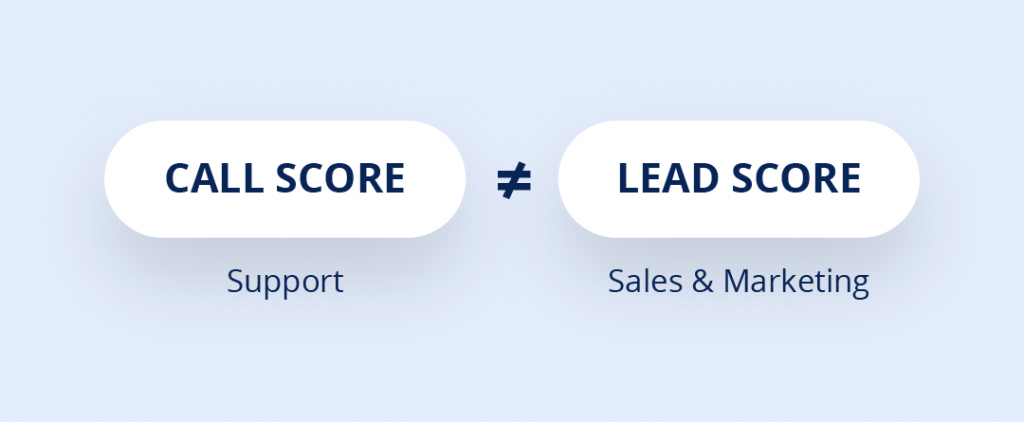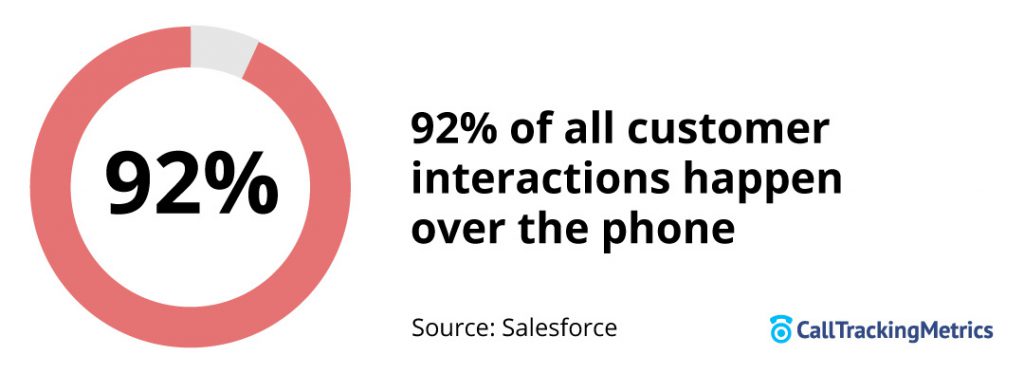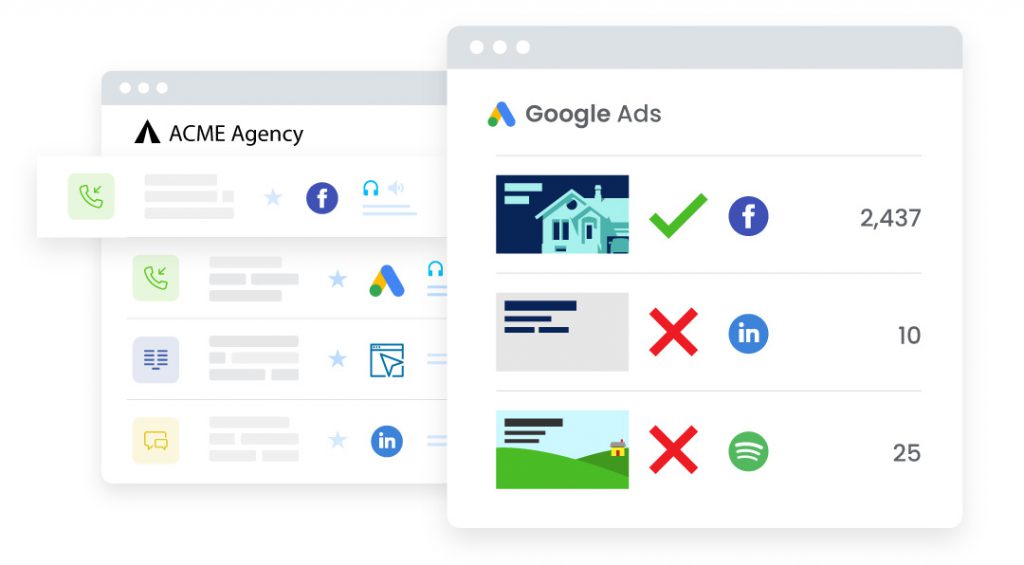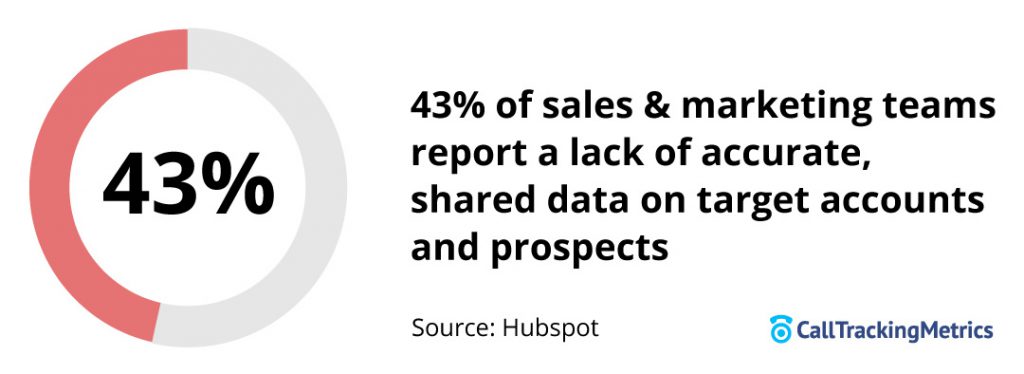What is Call Scoring? (It’s Not Exactly Lead Scoring)
Call scoring is the process of assessing data from a phone call against a predefined set of performance standards and then giving it a ‘score’. Call scoring, most often thought of as a tool for call centers, is highly effective for marketing and sales teams as well. Call scoring helps call centers determine if their agents are performing up to par and to be proactive with leads and customers. For sales and marketing teams, call scoring helps them know more about their customers, understand precisely which ads are working (and which aren’t,) and align their teams–all crucial components to consistently drive growth and revenue.
What does call scoring look like in practice? Call scoring for agents in call centers includes looking at how quickly the call was answered, if the problem was resolved, post-call survey data, accuracy of call script, and more. For sales and marketing teams, call scoring can include both demographic and behavioral information, including: location, company size, job title, persona fit, purchase intent, buyer’s stage, and conversion outcomes. Any call score will vary by industry and takes some time to implement and refine, making automation tools incredibly helpful. Once the call scoring system is in place and marketing and sales teams are aligned, the rewards are vast.
The Game-Changing Benefits of Call Scoring
Aligning sales and marketing teams is a sometimes-overlooked outcome of a solid scoring strategy. In fact, research shows that most sales and marketing teams aren’t aligned. Data from Zoominfo reports that only 8% of companies have aligned sales and marketing teams. For companies that can knock revenue operations alignment out of the park, the benefits include:
- Increased sales productivity
- Increased revenue
- Increased company growth
- Increased lead generation
- Increased customer satisfaction
- Shortened sales cycle
When these two teams are strategically aligned around the same revenue generation goals, there is tremendous potential for important increases across the company.

The Difference Between a Call Score and a Lead Score
Is call scoring the same as lead scoring? Not quite!
Traditionally, lead scoring is associated with the buyer’s journey of sales and marketing teams, while call scoring is associated with customer experience measures for support teams. Leads come from actions like form fills, chatbots, and even calls. Lead scoring is similar to call scoring in that it uses a predefined set of performance metrics, evaluates leads against these, and assigns a ‘score’. Much like call scoring, this assigned score then determines the next steps taken to follow up and lead the prospect through a sales funnel. While there are similarities between lead scoring and call scoring, it’s important to realize that these are different tools. Learn more about how to build a score for any team in this guide.
With lead scoring, the goal is to analyze leads that are coming in and qualify them, move them further in the sales process, or continue nurturing them. This helps sales prioritize who to call back first and gain an understanding of what qualities their strongest leads have. Call scoring is specific to phone calls, of course, but the person on the phone may already be a customer and there’s an entire conversation available to inform your score. The data learned on the call will help sales and marketing in other ways, specifically with strategies, training, and planning.
With so much of our lives happening online, marketing and lead scoring strategies tend to focus only on digital activity. But, according to Salesforce, 92% of all customer interactions happen over the phone. So if you’re not paying attention to what’s being said on the phone by both your team and your customers, you’re missing a huge opportunity. With third-party data being less accessible, gaining this important insight with call scoring and first-party data is more critical now than ever.

Call scoring helps sales and marketing teams to pinpoint the following valuable information:
- Specific stage of the buyer’s journey
- Specific ad campaigns driving the most calls and conversions
- Most common pain points, objections, and questions
This first-party data is vital in fine-tuning marketing campaigns’ ad spend and messaging, as well as developing marketing materials, determining nurturing campaigns, and providing valuable content that speaks to your prospects’ and customers’ pain points. With this insight, sales and marketing can align around the same data, making for better campaigns and increased revenue.
3 Ways Sales and Marketing Can Use Call Scoring
As mentioned, lead scoring is typically the ‘go-to’ scoring for marketers. However, call scoring can provide a wealth of information about your customers that you can’t get anywhere else. Armed with this information, you can make more confident, data-backed decisions about not only where to spend advertising dollars, but also what types of content to create–and on which channels.
Let’s explore three ways sales and marketing teams can utilize call scoring to increase quality leads, drive conversions, and ultimately increase ROI.
1. Discover the stage of the customer’s journey
All marketers know that you must reach your audience with the right message at the right time. This, in large part, depends on what stage of the customer’s journey your prospect is in when they call. Knowing what stage your prospect is in can help to determine what the follow-up process will look like and increase your chances of reaching them at the right time with the right information.
For example, if your call scoring has found that a caller is at the beginning of the customer’s journey your team will most likely want to email them some follow-up materials that help them learn more about your company and products. At this first stage, prospects are generally just ‘kicking the tires’ and will take some time to research competitors. Providing valuable resources to this person after the call can make the difference between a future customer or a lost customer.
You can determine what stage your buyer is in by looking at:
- Type of content viewed – Someone who called after reading a few blog posts or attending a webinar is just starting their journey. Or, maybe, they’re closer to buying and checking out your pricing page and integration specs.
- Conversation analysis – The words your prospects and customers use are powerful. You can hear directly from them what they need.
- Are they looking for general information about the company or are they asking questions about a specific product?
- Have they mentioned any content they have read from your website?
- Do they have an understanding of your product or service or are they just discovering it?
- What words are they using? Words like demo, prices, sale, trial, etc. all indicate they are further down in the funnel. Words like learning, researching, curious, etc. reveal they are in the beginning stages of the funnel.
When you know what stage your customer is in, you can provide more valuable and meaningful engagements. Personalizing the interaction as much as possible by providing content that meets the buyer exactly where they are in the buyer’s journey is invaluable. This tells your prospect that you’re paying attention and want to help them. Continuing to nurture this relationship is key.
In fact, research from MarketingDonut found that 80% of sales required five follow-up calls while 44% of sales reps give up after one. By determining which stage of the customer’s journey callers are in, you can appropriately follow up with them, nurture the relationship, and ultimately convert them to happy–and loyal–customers.
It’s important to understand that today’s customer journey is different, and there’s never just one path to purchase. Not everyone enters at the awareness stage and there’s often movement back and forth within the three stages. Call scoring helps quantify a caller’s stage, rather than relying on assumptions.
With no call scoring in place, any first-time caller might receive follow-up with the assumption they’re at the top of the funnel, providing only some basic company and overall product information.
However, if that same first-time caller asked about pricing, came from a targeted paid ad, and asked about technical specs, this indicates that they are way lower on the funnel, maybe even ready to buy. Scoring them as a 4-star call, or adding scoring tags, signals to everyone in the organization that this is a serious candidate. The follow-up action changes drastically from sending a company overview to a link to sign up for a demo or info on current promotions.
According to HubSpot, 79% of marketing leads never convert into sales, often due to a lack of lead nurturing. The follow-up and nurturing piece of sales and marketing is crucial. Call scoring gets you one step closer to doing this right.
2. Understand exactly which ad campaigns work (and which don’t)

When it comes to advertising campaigns, many marketers instinctively know which ones are working and which aren’t–or at least they have a hunch. However, being able to pinpoint exactly which campaigns are driving calls and conversions and having the data to back it up provides tremendous value. Call scoring enables marketers to track, monitor, and report on campaign performance. Consistent, real-time monitoring and reporting can lead to minor–and sometimes major–adjustments in ad campaigns. These tweaks and adjustments can make a big difference in campaign performance.
This also helps to align sales and marketing teams. When they both know what’s working and what isn’t, they gain insight and can focus their efforts around the campaigns that are producing results. Aligning sales and marketing teams around these metrics ensures that everyone is on the same page and understands what campaigns are really driving sales and why. This enables teams to better understand the customer and also spend their marketing dollars wisely.
When call scoring shows which ad campaigns work best, teams also gain insight into which marketing strategies are working best. With tools like keyword spotting and transcriptions, marketers uncover what questions are being asked around certain campaigns. This helps sales know ahead of time what questions are most asked around each specific campaign and allows them to be prepared with answers. When sales knows what to expect, they can even have specific examples and case studies to help the customer even more. Marketing then knows what collateral to create to answer the most frequently asked questions, how to fine-tune campaign content, and gains a deeper understanding of the customers’ needs and pain points–and can prioritize material to support that too.
For example, if call scoring reveals that 70% of callers from Ad A ask two of the same questions, marketing is able to take a look at the ad campaign and see if they can adjust it so that these questions are answered. Or, if these are just common questions around the campaign, marketing can develop a one-pager answering these questions. On the other hand, if the same questions are coming from multiple ad campaign callers, maybe marketing will consider creating an eBook or infographic to address these questions for a wider audience.
It’s important to not only spend ad dollars wisely but to also use your team’s time effectively. When time is spent creating content that isn’t speaking to the customers’ needs, you’re wasting valuable time and money. According to the Content Marketing Institute, this happens far too often. CMI reports that 60-70% of B2B content created is never used, often because the topic is irrelevant to the buyer audience. Call scoring helps teams to create the content customers want.
3. Uncover most frequently asked questions, pain points, and objections
It’s vital for sales and marketing teams to give customers the information they want and need. And, there’s nothing quite as valuable as getting information directly from your customers. With third-party data going by the wayside, using call scoring to find out more about your customers directly from them with first-party data is more important than ever.
As mentioned, with conversation intelligence tools like transcriptions and keyword spotting, teams can automatically score calls and identify prospects’ pain points, common objections, and most frequently asked questions. This, in turn, can lead to creating marketing materials to address those common pain points and objections as well as give more in-depth answers to questions.
When it comes to content marketing, understanding pain points–and speaking to them–is vital. Marketers who speak directly to these prospects’ pain points (and answer their questions) have a much better chance of converting prospects to customers. And, after all, that’s the ultimate goal of both sales and marketing teams.
Additionally, when sales is armed with materials addressing pain points, most-common objections, and most-asked questions, they are able to be more proactive with customers. Knowing what their customers’ questions will be ahead of time puts them in a much better position to answer them, and ultimately helps the prospect solve their problem. When a company not only speaks to the pain points, but also illustrates how their product or service can solve those problems, teams are one step closer to closing a deal and creating a loyal customer.
Aligning Sales and Marketing for Success
Call scoring provides another layer of data for sales and marketers to better understand and speak to customers, align their teams, be more effective, and ultimately increase revenue. If your teams aren’t aligned, it may seem like a lot of work to get there but call scoring can make it easier and it’s well worth the effort. According to a report from HubSpot, 43% of sales and marketing teams said “lack of accurate/shared data on target accounts and prospects> was the biggest challenge when it comes to aligning sales and marketing departments. In today’s competitive landscape, it’s essential to have these teams aligned.

CallTrackingMetrics offers highly-customizable tools that enable teams to automate call scoring making it even easier to learn more about prospects, gain insight into their problems, and create sales and marketing strategies to consistently increase conversions and drive revenue. Ready to align your sales and marketing teams and increase revenue? Download our guide, developed alongside MarketingDive, to discover how CTM helps to solve sales and marketing misalignment.

